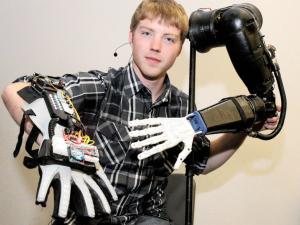The next great breakthrough in robotic technology may have come out of a Colorado teenager’s bedroom. The story of Easton LaChappelle, now 19, is certain to go down in the annals of technology lore—a kid who invented a robotic hand, controlled wirelessly, using stuff he found lying around the house: electric tubing, fishing line, RC motors, LEGOs. And then went on to develop an entire arm, shoulder to fingertips, using 3-D printing techniques. And then started dabbling in neuroscience to figure out how to tap into brainwaves in order to control prosthetic limbs and other robotic devices.
His goal: to make this technology accessible—and affordable—to those who need it most. His prototypes cost around $500—a must-have price point for a kid learning to assemble high-tech parts with money from birthdays, part-time jobs and, later, science fair wins. Compare that to the tens of thousands of dollars amputees and those with birth defects spend on their limbs.
 Did we mention he was 19?
Did we mention he was 19?
LaChappelle is in Naples today, the keynote speaker for an Entrepreneur Society of America gathering tonight at The Naples Beach Hotel & Golf Club. Earlier, he met with Gulfshore Life to tell us more about his amazing ride from small-town kid to globe-trotting inventor and entrepreneur. Here are some snippets from our conversation. (Responses are lightly edited for clarity and length.)
GL: What are your earliest memories of inventing?
EL: You know, you probably have to go back to when I was 6 years old or so. I was one of those kids who had to take apart everything I got, from microwaves to toasters to game consoles. I was always curious about what was happening on the inside. Once I took things apart, everything had these black chips that were sort of the brain of these things. I was mesmerized by how these worked.
GL: Why a robotic hand?
EL: I don’t really know why a robotic hand. I think it was something I could relate to. It seemed like a challenge to replicate, but it would also be really cool to see something that was close to the human body.
When I put on this (control) glove, the hand would copy my movements. … This project was a simple, basic project, but there are so many ways to improve it to elaborate on it, to make it better, to optimize it so much more.
GL: You must have had to be pretty resourceful—both financially and in terms of learning the technology.
EL: I had to get creative. I had probably $100-150 for this first project, and that was money from birthdays and things like that. That in itself was a challenge to work around. So that’s why I had to re-purpose what was out there.
[LaChapelle studied mechanics and engineering and other topics on his own, but he discovered there was no model for him to copy]
I was crossing my fingers that there would be a nice YouTube tutorial or something like that, but there wasn’t. So I actually made a YouTube tutorial and I made it open source, which means I released all the software and encouraged people to replicate it, change it, and make it better and better. That was one of the biggest things for me—that’s how I learned a lot of this, talking to people in an opensource community and begin able to ask questions….I was able tot talk to people all around the world.
GL: Tell us about your hometown.
EL: I’m from Mancos, a very small town in Southwestern Colorado, around 1,300 people. There’s not too much industry or jobs right there—mostly agriculture and farming. We have an elementary, middle and high school. They are all on the same campus, right on the same block. My graduating class was right around 23 students.
GL: What do your parents do?
EL: My mom was a librarian for about nine years and my dad works for UPS. They really aren’t into technology, and they really don’t know what I do as far as the technology but they’re extremely supportive. I definitely owe a lot to them.
GL: Did you tear apart your house looking for parts?
EL: Yeah, pretty much. My dad had to bring a fire extinguisher into my bedroom a few times.
GL: Describe your childhood bedroom.
EL: I pretty much had a bed in the corner. That was my living space. Everything else was a giant steel stand to hold these arms, all sorts of prototypes, soldering stations, tools, vices; I pretty much had everything I needed to create a full robotic arm and program it. I liked working during the night. It was my zone, and I could work for hours on end.
GL: When did you decide to apply your research into prosthetics?
EL: (At the state science fair when I was a sophomore), I noticed this small girl. She was looking at the fingers. She wanted to know how it actually worked. She was intrigued, and that caught my eye. I started talking to her parents and found out this girl had a prosthetic limb. That was the first time I was exposed to something like that. It was a very simple prosthetic from the elbow to the fingertip, one motion, open close and one sensor, and just that alone was about $80,000. For me, it was truly an ah-ha moment. I looked at what I had created; it was similar to what she had—actually it was probably better than what she had. … I knew I could re-purpose it as a prosthetic and impact someone’s life. That was a huge boost in motivation.
GL: So one of your driving principles is to keep the technology affordable?
EL: My vision was to get it to everybody in the world who needs this. But I got a dose of reality and that was there are so many barriers to entry in the medical market. You have to go through FDA, you have to collect data and support your medical claims. It’s a whole process and that takes a tremendous amount of money as well as infrastructure, which is something I didn’t have either of.
GL: So you adopted an open-source model?
EL: The prosthetics industry is one of the few that hasn’t really changed in the past 30 years. There are three main global companies that pretty much run it. For a small company to come along and pass through FDA is really impossible at such a small stage. I kind of knew my options. It wasn’t practical to go through the FDA process, at least at this time, but if I made it open source, it allows someone to take this from me essentially and replicate it and make it their own or find someone else who could make it or potentially get some pieces from us that they could use.
GL: How do you make money?
EL: There are lots of different applications. We can sell kits of these, we do have a printer, we can sell hardware kits. [LaChappelle is founder of Unlimited Tomorrows. His investor partner is leadership guru Tony Robbins, who contacted the young man after hearing his 2013 TED Talk.]
What we’re really into right now and what is bringing in revenue for us is industrial control systems. … How do you merge man and machine in the right way?
Something we saw from prosthetics to the exoskeletons that we are prototyping—we are really looking at many industries that are robotics or automated or use heavy machinery, we are looking at the controls. With prosthetics, that was something that was really lacking: How do you merge man and machine in the right way?
GL: You are looking to harness brainwaves to control technology, correct?
EL: When I started diving into the brainwave part, I was probably 15 or 16, and the first headset I got was from Walmart. There was this game called Mindflex where you wear a little headband and you focus and the ball goes up and down. I took that headset and gutted it. It was able to read something from your brain, and I wanted to figure out what it was.
I hooked it up to the computer and started graphing all the (brain) waves I got from it. I sat in front of the computer for hours. I tried to figure out a wave that I could control very easily and accurately. I would do all sorts of different tasks such as reading or concentrating or maybe feeling different emotions to try to figure out if there was something I could easily control. Eventually, I did find it in a combination of waves. … I eventually wrote software to bond that to the hand.
GL: What will you tell your audience in Naples?
EL: For my journey, it definitely wasn’t easy, and I want to put that in perspective. You have to be resourceful. If you put your mind to it, you can easily achieve it. In this world today, we have so many opportunities, literally at our fingertips. If you want to learn something, if you want to do something, you can. And at the core of that is curiosity and harnessing that curiosity and using it as a tool. Find your passion, run with it, and if you can make a difference doing that, you’ve lived a great life.





